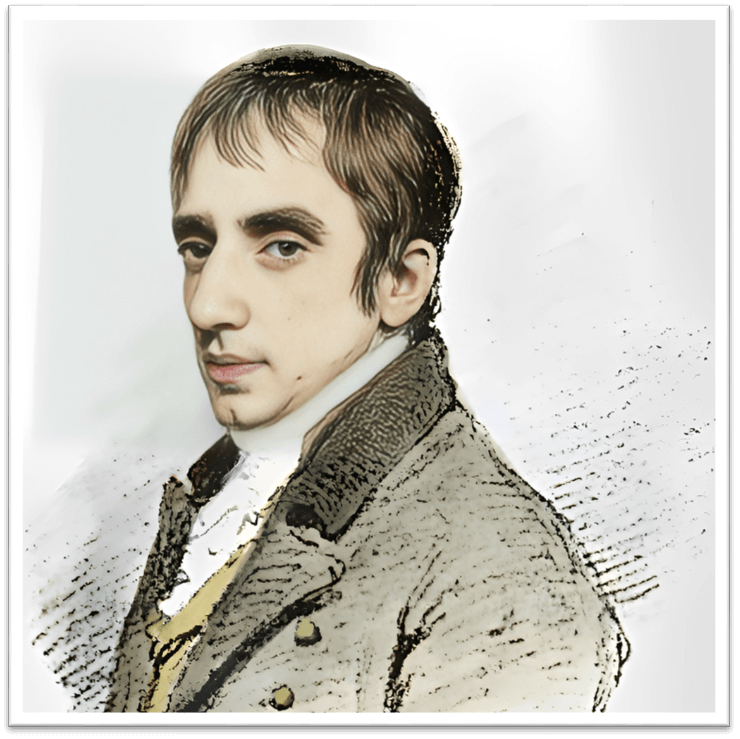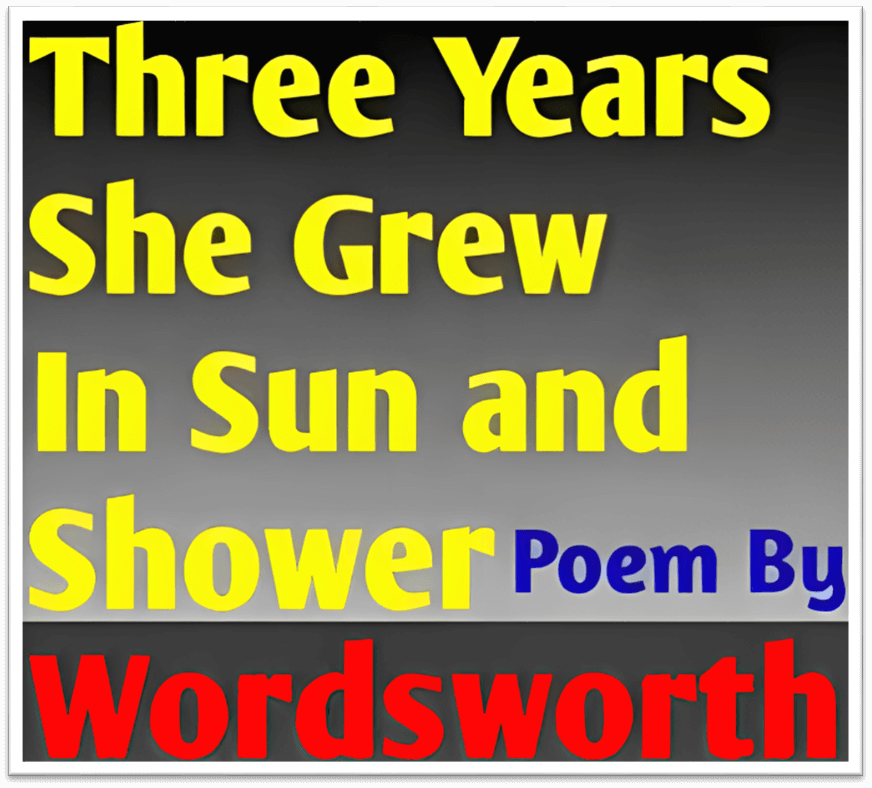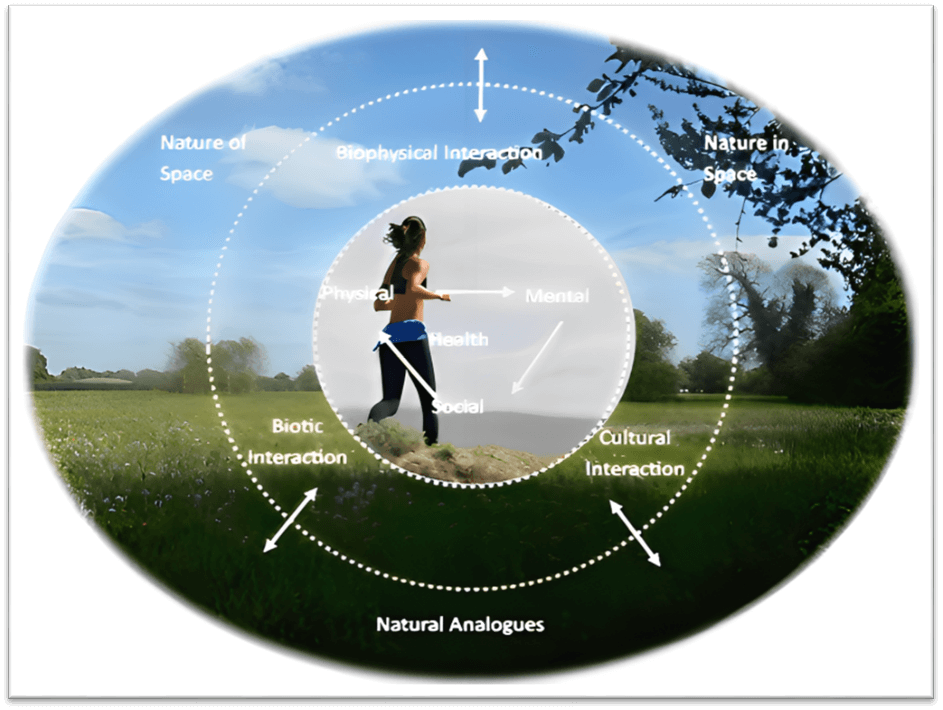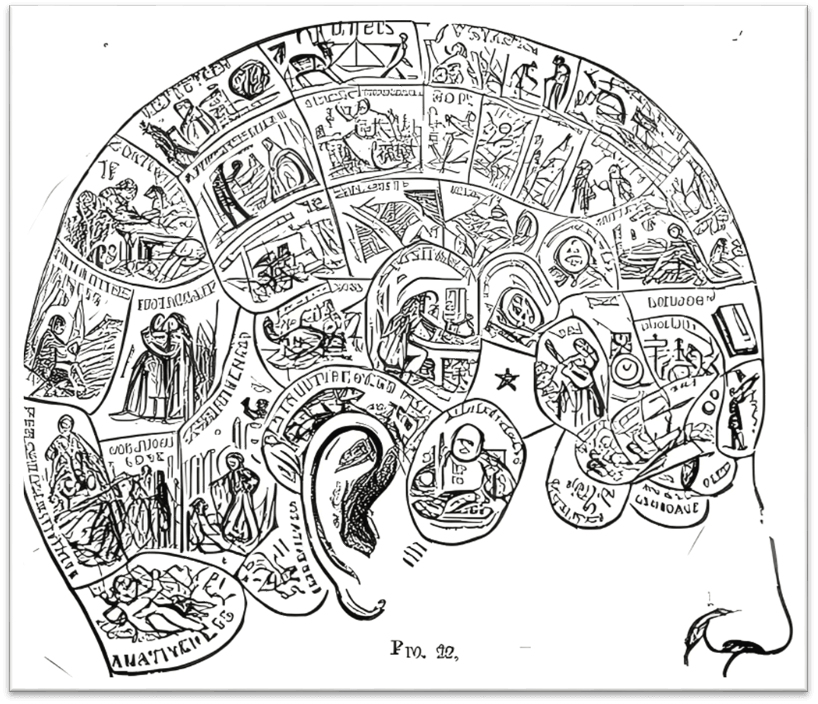Three Years She Grew in Sun and Shower
William Wordsworth's poem "Three Years She Grew in Sun and Shower" examines how people and nature interact, how time moves forward, and how fleeting life is. The essence of the natural world and its deep influence on our lives are captured in Wordsworth's poem, which was written during the Romantic period. The poem encourages readers to consider existence's beauty and transient nature through rich imagery and profound symbolism. In this post, we'll go into an overview and study of "Three Years She Grew in Sun and Shower," looking at its themes, structure, and the words of Wordsworth's timeless composition.

Significance of the Poem & its Author:
One of the most well-known poets of English Romanticism, William Wordsworth, has an important place in the canon of literature. Born in 1770, Wordsworth was a pivotal player in the Romantic movement, which arose in the late 18th century as a response to the Industrial Revolution and the rationalism of the Enlightenment. He and his friend Samuel Taylor Coleridge produced the ground-breaking book "Lyrical Ballads" in 1798, ushering in the Romantic era and indicating a change in literary sensibility.
Poetry by Wordsworth is renowned for emphasizing nature, the imagination, and the individual's emotional and spiritual experiences. He strongly believed in nature's ability to uplift and inspire people. His writing frequently deals with the sublime, our interaction with nature, and the transformational power of memory. He played a pivotal role in creating contemporary English poetry because he concentrated on daily language and his capacity to portray the beauty of the ordinary.
One of Wordsworth's well-known poems, "Three Years She Grew in Sun and Shower," illustrates his close relationship with nature and his reflection on the transient aspect of existence. The poem is an important part of Wordsworth's body of work since it incorporates numerous distinctive topics and stylistic elements. It encourages readers to consider nature's profound influence and the precarious harmony between the rhythms of nature and human existence. Wordsworth's ongoing significance as a poet is cemented by the poem's analysis of life's fleeting nature and the beauty present in even its most fleeting moments, which resonates with readers of all generations.
Overview of the Poem's Storyline:
A narrative poem called "Three Years She Grew in Sun and Shower" narrates the tale of a little girl named Lucy. The poem explains how Lucy grew up in harmony with nature, spending her first three years surrounded by the sun and rain, which stand for the cycles of life and growth. Wordsworth depicts Lucy's happy and blissful life, where the natural world fosters her.
But tragedy hits when Lucy tragically dies at the age of three. The poem then reflects on her brief life and her effect on those who knew her. Wordsworth muses how those who loved Lucy will always remember her as vividly as a sweet flower or a fading star.
The story's ending conveys an important lesson about the cyclical nature of life and death. Wordsworth implies that even if Lucy is no longer physically there, she is still present in the harmony and beauty of the natural world. The poem reminds us of the transient nature of life and the lasting effects of our relationship with nature.
Overall, the story of "Three Years She Grew in Sun and Shower" conveys the nostalgic journey of a little girl's life while examining themes of transience, the cycles of nature, and the strength of memory.

Key Themes and Ideas:
The poem "Three Years She Grew in Sun and Shower" dives into several significant themes and concepts that are distinctive to Wordsworth's poetry and the Romantic period. The following are some of the poem's key themes:
- Nature's Influence: The poem highlights the enormous influence of nature on human existence. It portrays nature as a nourishing force that creates and preserves life. The development of Lucy and her bond with nature represents how well people and the environment get along.
- Transience and Mortality: Wordsworth muses on the transience of existence and the certainty of death. The poem emphasizes that even the tiniest and most innocent souls are subject to mortality, recognizing the fleeting nature of human existence. This theme encourages Readers to consider the brittleness and value of life.
- Memory and Remembrance: Wordsworth examines the strength of memory and the enduring effects of the deceased. The poem implies that even though Lucy is no longer physically present, her memory endures in the minds and emotions of those who adored her. This topic focuses on how important it is to cherish loved ones' legacy and preserve memories.
- Beauty in Impermanence: The poem discovers beauty in life's temporary and transient facets. The fleeting moments and the delicate balance between growth and decay are celebrated. Wordsworth contends that despite Lucy's brief existence, her beauty and soul continue in the unending cycles of nature.
- Harmony and Unity: The poem emphasizes how closely related people are to the natural world. It emphasizes how people can come together in harmony and peace when they are in tune with the cycles of nature. This subject encourages respect and admiration for the environment and supports a closer connection to the natural world.
By examining these issues, Wordsworth encourages readers to consider their mortality, the importance of the natural world, and the enduring power of memory and love. The poem promotes a deeper understanding of the fleeting beauty around us and the significant influence that even the shortest lives may have.
The Main Character:
The protagonist and key figure of "Three Years She Grew in Sun and Shower" are Lucy, a little girl who develops in intimate harmony with nature. Although Lucy is shown as a particular person, she also represents the more general themes of innocence, transience, and the connection between people and the natural environment.
Lucy's character exemplifies the transient quality of life and the frailty of the human condition. Throughout her three years of existence, she is nurtured by the sun and shower, representing the cyclical nature of growth and the fleeting beauty of youth. Being around Lucy is a constant reminder of how short life is and how transient humans are.
Despite the poem's lack of in-depth discussion of Lucy's personality or character traits, her function in illuminating the themes and concepts that Wordsworth explores is crucial. By Lucy's fleeting but profound presence, readers are inspired to consider their mortality, the value of savoring our moments, and the enduring relationship between people and nature.

Poem's Structure and Form:
The poem "Three Years She Grew in Sun and Shower" has a regular meter and a reliable rhyme pattern. It is divided into six stanzas, each with four lines and an ABAB rhyme pattern. The poem's form and organization create a rhythmic flow and lyrical feel.
The poem has an iambic tetrameter structure. Iambic feet are made up of two syllables, the first of which is unstressed and the second of which is stressed. The poem uses Four iambs consistently, giving it a constant and musical beat.
The poem's musicality and harmony are enhanced by the poem's recurring ABAB rhyme pattern. The final rhymes give the verses a satisfying and memorable character while establishing a pattern and tying the stanzas together.
Overall, "Three Years She Grew in Sun and Shower" has a structured shape and regular meter, which add to the poem's musicality and enable readers to follow its rhythmic flow and recognize Wordsworth's use of lyrical language.
Language and Imagery Used by Wordsworth:
In "Three Years She Grew in Sun and Shower," Wordsworth expertly crafts vivid language and imagery to elicit his message and provoke a profound link between nature and human existence. Here are some noteworthy examples of the poem's language and imagery:
- Nature Imagery: The poem revolves around Wordsworth's use of natural images. Using terms like "sun" and "shower," he describes Lucy's development and relationship with the outdoors. These pictures emphasize nature's regenerative and transforming force by representing the cycles of life and growth.
- Sensory Details: Wordsworth uses sensory-stimulating imagery to engage the reader throughout the poem. Examples include the "fragrant flower" and the "star that fades away." These sensory nuances capture the reader's attention and help them to envision and feel the story vividly.
- Symbolism: Wordsworth uses symbolism to communicate underlying meanings. Lucy is depicted as a representation of youth and the fleeting aspect of life. The star and the flower, employed as metaphors, stand in for life's beauty and fleeting nature. These symbols enhance the poem's theme investigation and encourage readers to consider the story's wider ramifications.
- Contrast: To highlight the fleeting nature of existence, Wordsworth uses contrast. To emphasize the transient essence of human existence, he contrasts Lucy's three years of development with her sudden death. The poem has emotional depth from the juxtaposition between growth and mortality, bringing attention to how fleeting life is.
- Lyrical Language: The lyrical nature of the poem is influenced by Wordsworth's use of words. To establish a rhythmic rhythm and heighten the musicality of the verses, he used literary devices like alliteration, assonance, and repetition. The poem's emotional effect is increased, and the lyrical language captures the reader's interest.
Wordsworth brilliantly weaves a rich and resonant tapestry of words that connects with readers by incorporating sensory details, symbolism, contrast, and poetic language. His use of language and imagery effectively conveys the poem's meaning and evokes strong feelings of admiration for the beauty and transience of existence.

The Relationship between Humans and Nature:
The poem "Three Years She Grew in Sun and Shower" tackles several subjects typical of Wordsworth's poetry and the Romantic period. Let's take a closer look at a few of these themes:
- Relationship between Humans and Nature: The poem emphasizes the strong bond between people and the natural environment. The development of Lucy in the sun and the shower represents how nourishing nature is to human life. Wordsworth depicts nature as a kind and generous power that creates and sustains life. The poem focuses on the harmony and togetherness that can be attained when people are in tune with the natural world's rhythms.
- Passage of Time: The poem's main topics revolve around time and how transient it is. Wordsworth considers how brief life is, especially in Lucy, whose development occurs over three years. The poem expresses recognition of the transient aspect of life and emphasizes the value of savoring every second. Wordsworth communicates that life, like these natural events, is fleeting yet leaves an imprint with the images of flowers and stars.
- The Transience of Life: The poem reflects on how fleeting life is and how death is inevitable. The abruptness and transience of human existence are brought home by Lucy's early age. The brief existence of Lucy, as depicted by Wordsworth, serves as a reminder that even the tiniest, innocent beings are susceptible to mortality. Readers are prompted by this theme to consider how short life is and to recognize the value and beauty of each moment as it is experienced.
- Beauty in Impermanence: Wordsworth views life's transience as having beauty and importance. Despite its shortness, Lucy's life is remembered for its beauty and influence while she was here. The poem claims that even if a person's physical presence may diminish, their spirit and memories live on in the endless cycles of nature. This subject encourages readers to cherish fleeting moments and discover beauty in life's impermanence.
Wordsworth asks readers to consider their relationship with nature, face the passing of time, accept the transience of existence, and find beauty in the fleeting moments by investigating these themes. The poem promotes a closer relationship with nature and a greater appreciation for the fleeting moments that make up our existence.
Symbolism Employed in the Poem:
Using symbolism, "Three Years She Grew in Sun and Shower" deepens its meaning and encourages reflection. Examining Wordsworth's use of symbolism and its meaning in the poem, let's see what it means:
- Sun and Shower: The sun and shower stand for the elements of nature that support Lucy's development. They stand for life's cycles, the passing of time, and the interdependence of people and the environment. The sun is a symbol of warmth, light, and life, while the shower is a symbol of renewal and expansion. Together, they represent how people and the environment may coexist peacefully while highlighting how the natural world can transform.
- Flower: The flower represents Lucy's existence and how fleeting it is. Lucy's life is shown as being fragile and transient, much like a flower that blooms and withers. The flower represents elegance, fragility, and the fleeting nature of life. It highlights the delicate balance between growth and deterioration and elicits a mixture of appreciation and melancholy.
- Star: The poem's allusion to the dying star serves as a reminder of how short life is. Like human lives, stars flash brightly but eventually wane and disappear. The star's fading is a metaphor for life's fleeting nature and the certainty of death. It lends the poem a hint of cosmic significance by implying that even the most magnificent heavenly bodies are vulnerable to the passage of time.
- Memory: The poem's use of memory as a motif is metaphorical. Wordsworth indicates that her memory endures even though Lucy is no longer physically present. Memory represents immortality, allowing people to carry on after their earthly lives. The poem emphasizes how important memory is in sustaining the character and influence of the deceased.

The poem "Three Years She Grew in Sun and Shower" expands its theme investigation and improves its emotional impact through symbolism. Readers are prompted to consider the transitory aspect of existence, the beauty found in impermanence, and the eternal legacy of individuals who have made an indelible impact on our lives through the symbols of the sun, shower, flower, star, and memory.
Overall Meaning:
The main ideas or takeaways from Wordsworth's poem "Three Years She Grew in Sun and Shower" are the fleeting nature of life, the interdependence of humans and nature, and the enduring strength of memory. Wordsworth challenges readers to reflect on the fragility and value of life by telling the story of Lucy's brief life.
No matter how young or innocent one is, the poem serves as a reminder that life is temporary. The development of Lucy and her early, unexpected death serves as a reminder of how fleeting life is and how inevitable death is. Wordsworth urges readers to think about their mortality and treasure the transitory moments that make up their lives.

The poem also accentuates the close relationship between people and nature. Lucy's development in the sunlight and shower is a metaphor for how nature can nurture people and how harmony may be attained when people are aware of their environment. Wordsworth encourages his audience to recognize the magnificence and transforming power of nature.
The poem's examination of memory emphasizes its importance in retaining the personality and influence of the deceased. Wordsworth contends that although Lucy is no longer with us physically, her memory endures, and her influence can still be felt in the unending cycles of nature. This highlights the lasting impact that people can leave behind, the value of cherishing memories, and the significance of paying tribute to those who have influenced our lives.
Overall, the poem's message encourages readers to embrace life's impermanence, develop a closer bond with nature, and appreciate how memories may capture the spirit of a person's loved ones. It demands an understanding of the beauty inherent in transience and a reminder to value each moment as a priceless gift.
The Romantic Era and its Characteristics:
A cultural and artistic movement known as the Romantic era began in the late 18th century and was most successful in Europe throughout the 19th century. It intended to emphasize feelings, imagination, individualism, and a strong connection with nature as a response to the Enlightenment's logic and industrialization. The Romantic period is best characterized by the following traits:
- Emotion and Subjectivity: Romanticism strongly emphasized the importance of feelings and personal experience. The era's writers and artists aimed to arouse strong emotional reactions in their audience and probe the depths of human passion, desire, and melancholy.
- Imagination and Creativity: Romantics praised the imagination as a potent instrument for creation and a means of escaping the limitations of daily existence. They valued using the imagination to investigate fanciful worlds, dreams, and the paranormal.
- Love for Nature: The majesty and beauty of nature received a lot of attention throughout the Romantic era. Nature was revered as a source of creativity, comfort, and spirituality. Romantics frequently portrayed wild and majestic natural settings in their attempts to capture the awe-inspiring elements of landscapes.
- Individualism and Introspection: Romantics valued each person's unique experiences, feelings, and viewpoints. Themes like self-discovery, introspection, and the search for one's identity were frequently explored and supported individual freedom and expression.
- Appreciation for the Past and Folklore: Historical relics, such as mythology and folklore from the Middle Ages, fascinated Romantics. They drew inspiration from legends, stories, and customs dating back thousands of years to establish a connection with a sense of common cultural history.

- Romantic Love and Idealization: Love's idealized and transformational nature was frequently depicted in romantic literature and art. Romantic love was viewed as a strong and all-consuming feeling that could cause both ecstasy and pain, resulting in tremendous emotional experiences and self-discovery.
- Political and Social Critique: While the Romantic movement was primarily concerned with feelings and individualism, it also expressed criticism of established institutions and standards. The dehumanizing impacts of industrialization, social injustice, and political oppression were frequently questioned by romantics, who argued for a more compassionate and egalitarian society.
These Romantic era traits impacted a range of artistic mediums, including poetry, music, painting, and sculpture. Romanticism left a long-lasting mark on Western culture, inspiring generations of intellectuals, artists, and aesthetic movements.
Wordsworth's Role as a Prominent Figure:
Being a well-known member of the Romantic movement, William Wordsworth had a huge impact. He is frequently recognized as one of the main protagonists of English Romanticism, and his poetry perfectly captures many of the major themes and traits of the time. Wordsworth's contributions to the Romantic movement can be seen in the following ways:
- Nature as a Source of Inspiration: The Romantic movement's emphasis on the natural world strongly aligns with Wordsworth's genuine admiration for nature and his conviction in its spiritual and moral importance. His poetry frequently examines nature's wonder, serenity, and transformational force, portraying it as a source of inspiration and peace. Wordsworth's depiction of nature reflects the Romantic interest in the sublime and the investigation of the personal relationship with nature.
- Emotion and Subjectivity: Wordsworth's poetry is renowned for its powerful emotional outpouring and examination of people's inner lives. From wonder and astonishment to grief and melancholy, he tried to convey the depths of human feeling. Wordsworth's emphasis on personal experience and the individual's inner world is consistent with the Romantic movement's emphasis on feelings and the strength of the individual's sensations.
- Celebration of the Ordinary: The normal people and everyday events that Wordsworth cherished in his poetry. He believed that ordinary lives and simple events might include beauty and meaning. His work's focus on the commonplace and democratic spirit reflects the Romantic movement's rejection of aristocratic principles and exaltation of the commoner.
- The Poet as a Prophet and Seer: Wordsworth regarded the poet as a visionary who could discern the ethical and spiritual realities of the universe. He believed poetry could inspire readers with profound insights and arouse their knowledge of the human predicament. This concept of the poet as a seer is consistent with the Romantic image of the artist as a prophetic figure and a source of inspiration and insight.
- Connection to the Past: While Wordsworth praised the beauty of nature, he also had great respect for the past and a passion for tradition and history. His poetry frequently used themes and motifs from folklore, myths, and old legends, displaying a connection to the past and an interest in the human race's cultural legacy.
Wordsworth's poetry and his status as a leading member of the Romantic movement influenced the ideals and aesthetic sensibilities of the time. His focus on subjectivity, nature, emotion, and the poet's role as a visionary figure resonated with other Romantic poets and artists, having a long-lasting influence on the growth of Romantic literature and thinking.

Other Poems that Share Similar Themes or Ideas:
The following poems by William Wordsworth are similar to "Three Years She Grew in Sun and Shower" in terms of their subjects or ideas:
- "Lines Composed a Few Miles above Tintern Abbey" (1798): This poem, sometimes known as "Tintern Abbey," examines the concepts of time, memory, and environment. Wordsworth considers his visit to the Abbey and how his surroundings have shaped his past and present. The poem explores the relevance of moments of communion with nature, the healing powers of nature, and the power of remembrance.
- "Ode: Intimations of Immortality from Recollections of Early Childhood" (1807): This ode explores youth, innocence, and the fleeting nature of life. Wordsworth laments the loss of the intense and spiritual connection to nature he once felt as a child. The poem says that young people have a deep grasp of the spiritual world, which fades with age.
- "I Wandered Lonely as a Cloud" (1804): Also known as "Daffodils," this poem celebrates the beauty of nature and the impact it can have on the human spirit. Wordsworth recounts an encounter with a field of daffodils and reflects on the lasting impression they leave on his mind, becoming a source of comfort and joy even in moments of solitude.
Recurring Motifs or Stylistic Techniques:
William Wordsworth's poetry employs several repeating themes and stylistic devices to create his unique voice and capture the spirit of Romantic literature. The following themes and literary devices are frequently used in Wordsworth's poetry:
- Nature Imagery: Several of Wordsworth's poems vividly and precisely describe the natural environment. He frequently uses nature as a metaphor, relying on its splendor, strength, and serenity to elicit feelings and sensory experiences. The romantic infatuation with the sublime and faith in the healing powers of nature are reflected in Wordsworth's depictions of nature.
- Solitude and Reflection: Themes of loneliness and introspection are frequently explored by Wordsworth. He portrays solitude and reflection as opportunities for introspection, serious thought, and spiritual development. Being alone catalyzes developing relationships with nature, self-awareness, and self-understanding.
- Use of Memory: Wordsworth's poetry heavily emphasizes memory. He regularly muses over past events and uses memory as a potent instrument to arouse feelings and shed light on the present. Wordsworth holds that memories have the power to alter one's understanding of the universe, as well as one's personal development.
- Simple Language and Everyday Life: Poetry by Wordsworth is renowned for its straightforward language and embrace of commonplace, everyday occurrences. To capture the genuine voice of the average person and establish a stronger connection with a larger readership, he shuns elaborate and complex vocabulary in favor of a more approachable style. Wordsworth finds meaning and beauty in everyday people's lives and the simplicity of life.

- Autobiographical Elements: Wordsworth frequently incorporates autobiographical themes into his poetry by drawing on his life experiences and views. He frequently blurs the line between fiction and reality by combining personal tales, memories, and emotions in his poems. His works gain an intimate and personal quality from this autobiographical element.
- Emphasis on Emotion and Subjectivity: In Wordsworth's poetry, feelings, and individual experiences are strongly emphasized. To elicit a powerful emotional response from the reader, he probes the depths of human emotions, including joy, grief, wonder, and longing. Wordsworth believes in the strength of every person's feelings and the individualized perspective that shapes how we see and comprehend the world.
- Reverence for Childhood: Wordsworth's poetry frequently explores childhood and its naive perspective. He frequently contrasts the difficulties and complexity of adulthood with children's innocence and unadulterated state. He celebrates childhood. In popular culture, childhood is seen as a time of enhanced perception, creative freedom, and a strong bond with nature.
Wordsworth's poetry is recognizable because of these motifs and stylistic devices. They exhibit his Romantic sensibilities, which strongly emphasize the value of one's own life experiences and emotions as well as poetry's capacity to uplift and transform the human spirit.
Conclusion:
- William Wordsworth, a well-known member of the Romantic movement, wrote the poem "Three Years She Grew in Sun and Shower."
- The poem examines how people and the environment interact, how time moves on, and how fleeting life is.
- It depicts the tale of Lucy, a child who grows and prospers thanks to nature's loving influence but eventually perishes.
- Regular rhyme and meter, which are characteristics of the poem's structure and shape, give the lines a lyrical feel. Wordsworth uses colorful language and images to express his ideas while evoking nature's wonder and transforming power.
- With an emphasis on the relationship between people and nature, the value of personal experience and emotion, and the investigation of life's transience, the poem echoes Romantic literature's larger themes and concepts.
- The sun, shower, and flower are just a few symbols used throughout the poem to represent development, nurturing, and the transient aspect of life.
- The poem's overarching message emphasizes the precarious and fleeting aspect of human existence while simultaneously praising the transforming abilities of nature and the lasting effects of memory.
- His profound respect for nature characterizes Wordsworth's status as a key player in the Romantic movement, his investigation of human emotions and subjectivity, and his celebration of the commonplace and the unique.
- His poetry is an excellent example of the main elements of Romantic literature, such as an emphasis on nature, an investigation of subjective sensations, a celebration of the commonplace, and a faith in the poet's authority as a visionary figure.
- Poems by Wordsworth that deal with related subjects include "Lines Composed a Few Miles above Tintern Abbey," "Ode: Intimations of Immortality from Recollections of Early Childhood," "I Wandered Lonely as a Cloud," and "The Solitary Reaper."
- Wordsworth's poetry demonstrates recurrent themes and stylistic devices such as nature imagery, seclusion, introspection, use of memory, plain language and everyday life, autobiographical components, stress on emotion and subjectivity, and reverence for infancy. These factors make his lyrical voice and contribution to Romantic literature more distinct.
|







 For Videos Join Our Youtube Channel: Join Now
For Videos Join Our Youtube Channel: Join Now











